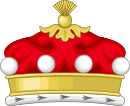| Baron Coleraine | |
|---|---|
  Blazon
| |
| Creation date | 16 February 1954 |
| Creation | Third |
| Created by | Queen Elizabeth II |
| Peerage | United Kingdom |
| First holder | Richard Kidston Law, 1st Baron Coleraine |
| Present holder | James Peter Bonar Law, 3rd Baron Coleraine |
| Heir presumptive | the Hon. Andrew Bonar Law |
| Status | Extant |
| Seat(s) | The Dower House |
| Motto | LEX TUA MEDITATIO MEA (Thy law my thought) |

Baron Coleraine is a title that has been created three times, twice in the Peerage of Ireland and once in the Peerage of the United Kingdom.
Contents
- Barons Coleraine, first creation (1625)
- Barons Coleraine, second creation (1762)
- Barons Coleraine, third creation (1954)
- References
The first creation came in the Peerage of Ireland in 1625 for the courtier Hugh Hare. This creation became extinct on the death of the third Baron in 1749.
The second creation came in the Peerage of Ireland in 1762 in favour of Gabriel Hanger, Member of Parliament for Maidstone and Bridgwater. The third Baron represented East Retford, Aldborough and Mitchell in the House of Commons. The fourth Baron was a soldier, politician and eccentric. The title became extinct on his death in 1824.
The third creation came in the Peerage of the United Kingdom in 1954 when the Conservative politician Richard Law was made Baron Coleraine, of Haltemprice in the East Riding of the County of York . He was the youngest son of the former Prime Minister Bonar Law. As of 2021 [update] the title is held by the first Baron's grandson, the third Baron, who succeeded in 2020.
The family seat is The Dower House, near Sunderlandwick, East Riding of Yorkshire.
